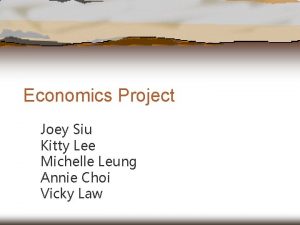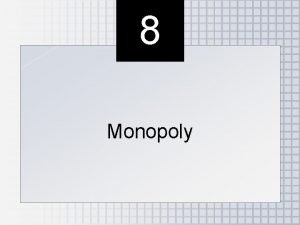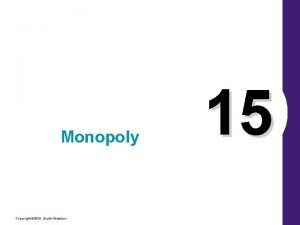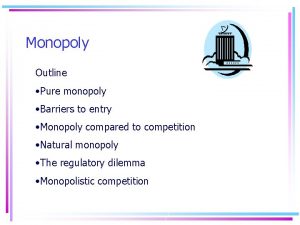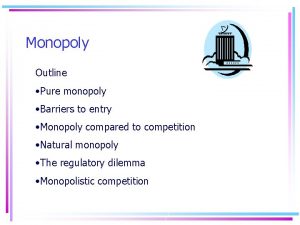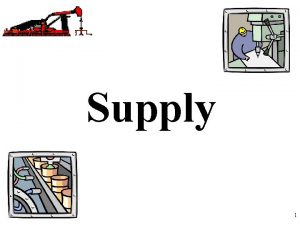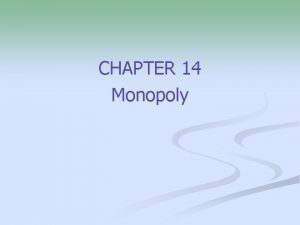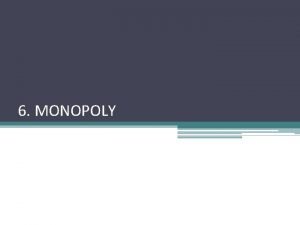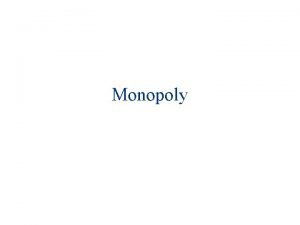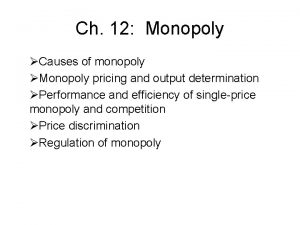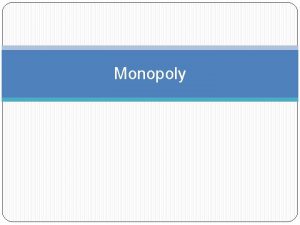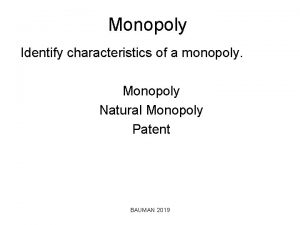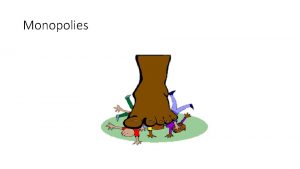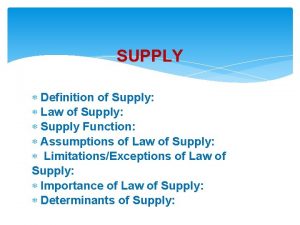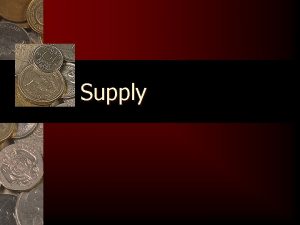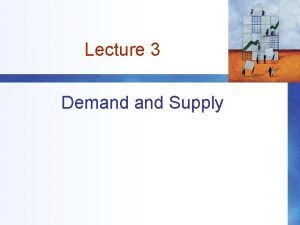8 Monopoly Outline Monopoly Defined The Monopolists Supply































- Slides: 31

8 Monopoly

Outline ● Monopoly Defined ● The Monopolist’s Supply Decision ● A Comparison of Monopoly and Perfect Competition ● Can Anything Good Be Said About Monopoly? ● Price Discrimination Under Monopoly

Monopoly Defined ● 1. 2. 3. Very stringent requirements for pure monopoly: Only one firm in industry. No close substitutes for the good firm produces. Some reason why entry and survival of a competing firm is unlikely. ● Pure monopolies are rare in real world because most firms face competition from firms producing substitutes. ♦ E. g. , sole provider of natural gas in a city is not a pure monopoly, since other firms provide substitutes like heating oil and electricity. ♦ E. g. , if there is only one railroad, it still competes with bus lines, trucking companies, and airlines. Copyright© 2006 Southwestern/Thomson Learning All rights reserved.

Sources of Monopoly Power: Barriers to Entry 1. Legal restrictions: Monopolies are established if gov. prevents other firms from entering the industry. ● 2. E. g. , licensing 1 cable TV supplier or right to operate a food stand in a public stadium. Patents: To encourage innovation, gov. gives exclusive production rights for 17 years to product's inventors. Monopoly is protected as long as its patent remains in effect. ● E. g. , for many years, Xerox had a monopoly in plain paper copying. Pfizer currently has a patent for Lipitor.

Sources of Monopoly Power: Barriers to Entry 3. Control of a scarce resource or input: If a good is produced with a rare input, a Co. that gains control of that input can establish a monopoly. ● 4. E. g. , De. Beers diamond syndicate controls S of highest quality diamonds in the world. Deliberately erected entry barriers: An incumbent firm can make it difficult for potential rivals to enter. ● E. g. , Spending huge amounts on advertising forces any potential entrant to match that expenditure to obtain customers. Intel has used its "Intel Inside" marketing campaign to ward off competition from AMD. Copyright© 2006 Southwestern/Thomson Learning All rights reserved.

Sources of Monopoly Power: Barriers to Entry 5. Large sunk costs: Entry into an industry is risky if it requires a large sunk I. Most important type of "naturally imposed" barrier to entry. ● E. g. , Boeing was the only supplier of top-end airplanes for many years after intro of its 747. Airbus receives gov. subsidies so it can afford the high I costs. Copyright© 2006 Southwestern/Thomson Learning All rights reserved.

Sources of Monopoly Power: Cost Advantages 6. Technical Superiority: A firm whose technological expertise vastly exceeds that of any potential competitor can maintain a monopoly for a period of time. ● 7. E. g. , For many years, IBM had little competition in PC business because of its superior technology. Economies of scale: If the size of a firm gives a cost advantage over a smaller rival, it may be impossible for anyone to compete with largest firm in the industry.

Natural Monopoly ● Natural monopoly is an industry where advantages of large scale production makes it possible for a single firm to S entire market output at a lower AC than a larger number of firms producing smaller Q. ● Once a firm is big enough, its natural cost advantage will drive competition out of business.

Average Cost FIGURE 1. Natural Monopoly $3. 00 B A 2. 50 C 2. 00 AC 1 2 2. 5 Quantity Supplied

Natural Monopoly ● Fig. 1 considers widget companies with ↓AC. ● Initially 2 firms in industry –larger firm with Q = 2 M and AC = $2. 50 and smaller firm with Q = 1 M and AC = $3. 00. ● Smaller firm can match P of larger firm only by operating at a loss. ● Larger firm can drive smaller firm out of business by selling its Q at $3. 00 > P > $2. 50 and still earn a profit. Copyright© 2006 Southwestern/Thomson Learning All rights reserved.

Natural Monopoly ● Once monopoly is producing 2. 5 M, IRTS are a barrier to entry because no entrant can match AC = $2. 00. ● If firm uses its low cost to keep P low, this benefits society. But once rivals exit, monopolist can ↑P. ● Public utilities are regulated because technology of producing their output enables them to achieve large ↓cost by ↑Q. ● Better to allow these firms to have entire market to themselves and have regulatory supervision vs. breaking them up. Copyright© 2006 Southwestern/Thomson Learning All rights reserved.

The Monopolist’s Supply Decision ● Monopoly does not have a S curve. ♦ Unlike competitive firms, monopoly does not take market P as given. It can select (P, Q) pair on industry D curve that max. Π. ● Monopolist’s D curve is downward sloping, not horizontal. ● Profits are not competed away by entry of new firms. ● To max profit, monopolist compares MR and MC. Copyright© 2006 Southwestern/Thomson Learning All rights reserved.

Relationship Between Price and Marginal Revenue ● Recall D = AR = P. ● If D curve is downward sloping, then P > MR. ● Monopoly charges same P to all its customers. To ↑Qd by 1, it must ↓P to all customers. So MR = P firm collects from the new customer - revenue lost by ↓P to all "previous" customers. Thus, P > MR. ● MR = P under perfect competition because firm's D curve was horizontal. Firm could expand Q without ↓P. Copyright© 2006 Southwestern/Thomson Learning All rights reserved.

FIGURE 2. Relationship Between Price and Marginal Revenue Monopolist sells 15 units for $2. 10 (pt A) and wants ↑ sales by 1. P must ↓ to $2. 00 to sell 16 th unit (pt B). How much revenue is gained? TRa = $31. 50 and TRb = $32. 00 so MR = $0. 50. So P = $2. 00 > MR = $0. 50.

The Monopolist’s Supply Decision ● To study P and Q decision of a profit-max monopolist (graphically): 1. Find Q where MR = MC to select the output level. 2. Find height of the D curve at that Q to determine P. 3. Compare P and AC to determine whether the monopolist earns a profit. Copyright© 2006 Southwestern/Thomson Learning All rights reserved.

FIGURE 3. Profit-Maximizing Equilibrium for a Monopolist Π-max Q = 150 where MR = MC. MC Price per Unit D P $10 AC Total profit is $6 x 150 = $900 and is represented by the area $10 P C 4. M 8 MC 4 AC C D (AR) MR 0 P = $10 > AC = $4, so per unit profit = $6. 150 Quantity

TABLE 1. A Monopolist’s Price. Output Decision Quantity Price Total Revenue Marginal Revenue Total Cost Marginal Cost Total Profit 0 ------ $10 ------ -$10 1 $140 70 $60 70 2 107 214 74 120 50 94 3 92 276 62 166 46 110 4 80 320 44 210 44 110 5 66 330 10 253 43 77 6 50 300 -30 298 45 2

The Monopolist’s Supply Decision ● 1. Table 1 illustrates several important points: ↓P will raise (lower) TR when D is elastic (inelastic). ♦ 2. 3. E. g. , D is elastic (inelastic) from Q = 1 to Q = 5 (from Q = 5 to Q = 6). P > MR after 1 st unit of output. Highest profit ($110) at Q = 4 where MR = MC = $44. Copyright© 2006 Southwestern/Thomson Learning All rights reserved.

A Comparison of Monopoly and Perfect Competition 1. A monopolist' profits persist: ● No barriers to entry in competitive markets so profits are competed away. In LR, firms only cover their costs, including opportunity cost of K and L. ● But economic Π can persist under monopoly. Monopolies are often regulated by gov. agencies that try to limit Π they earn. 2. Monopoly restricts output to raise price: Compared with the ideal of perfect competition, monopolist restricts Q and charges a higher P. Copyright© 2006 Southwestern/Thomson Learning All rights reserved.

A Comparison of Monopoly and Perfect Competition ● ● Imagine a court order breaks up a monopoly into large # of competitive firms. Assume industry D and costs stay same. Somewhat unrealistic, but it allows us to compare LR (P, Q) pair under monopoly vs. perfect competition. Copyright© 2006 Southwestern/Thomson Learning All rights reserved.

FIGURE 4. Compare Monopoly to Competitive Industry Monopoly Q = 150 → MR = MC (pt M). MC Price per Unit D AC P $10 M Monopolist produces less Q and charges a higher P. B 8 MC AC D (= AR = P = MU) C MR 150 Comp. Q = 300 → P = AC (pt B). 300 Quantity

Monopoly Leads to an Inefficient Resource Allocation ● ● Competitive industries produce what society wants at min possible cost. Efficiency in resource allocation requires that MU = MC. This occurs under competition because industry produces where D (or MU) = MC. Yet, monopolist produces smaller Q where MU > MC. So consumers are willing to pay more for an add. unit than it would cost to produce it. Resources are allocated inefficiently under monopoly, because too few resources are used to produce the good. Copyright© 2006 Southwestern/Thomson Learning All rights reserved.

Can Anything Good Be Said About Monopoly? ● Monopoly may aid innovation: ♦ Monopolies are shielded from competition, so any innovation that ↓costs → ↑profits. ♦ Monopolies may have more incentive to invest in R&D. ♦ In SR, ↑AC with R&D spending, but in LR, ↓AC with use of new technologies or production processes. Copyright© 2006 Southwestern/Thomson Learning All rights reserved.

Can Anything Good Be Said About Monopoly? ● Natural monopoly: ♦ ↓AC as ↑Q ♦ Costs of production would be higher if a natural monopoly were broken up into many smaller firms. ♦ Society benefits from monopolist’s ↓AC (or IRTS). ♦ Must be regulated for consumers to receive lower P. Copyright© 2006 Southwestern/Thomson Learning All rights reserved.

Price Discrimination Under Monopoly ● Charging different customers different prices when cost of supplying them is the same. ♦ E. g. , airlines charge less to passengers willing to stay overnight on Sat. ● Or charging different customers same P when cost of serving them is different. ♦ E. g. , U. S. P. S. charges same P for delivery of letters. Can you think of some examples of P discrimination? Copyright© 2006 Southwestern/Thomson Learning All rights reserved.

Price Discrimination Under Monopoly ● P discrimination occurs in many industries, but it is easier to accomplish if firm is sole producer of a good. ● P discrimination → more profitable to sell to 1 group than another. ● With competition, firms enter and steal profitable customers away by charging them slightly lower P. Copyright© 2006 Southwestern/Thomson Learning All rights reserved.

Price Discrimination Can Raise Profits ● Example: Town where widgets are sold 100 rich families → willing to buy 1 if P = $30 1, 000 poor families → willing to buy 1 if P = $10 ● If firm cannot P discrim. → charge everyone P =$10. ♦ TR = $10 x 1, 100 = $11, 000 If instead, it charged P = $30 to everyone ♦ TR = $30 x 100 = $3, 000 ● If firm can P discrim. (and keep poor from reselling to the rich). → TR = $13, 000 = $10 x 1, 000 + $30 x 100. Copyright© 2006 Southwestern/Thomson Learning All rights reserved.

FIGURE 5. Prices and Quantities under Price Discrimination Customer Group A Customer Group B Da Db Pa Price Pb MC 0 J Qa K MRa Quantity Da 0 Qb MC MRb Quantity Find Π-max (P, Q) for each group by: (a) optimal Q is where MR = MC; and (b) P is determined by height of D curve at optimal Q. Db

Price Discrimination Under Monopoly ● Profit max. requires MRa = MRb = MC. ♦ E. g. , if MRa = $18 and MRb = $15 → switching sales from group B to group A raises TR by $3. ● Fig. 5 assumes MC are equal across the 2 groups and that MC is constant. ● Optimally, sell Qa to group A and Qb to group B. These quantities ensure that MRa = MRb = MC. ● Group B (with more elastic D) is charged a lower P than group A (with less elastic D). Copyright© 2006 Southwestern/Thomson Learning All rights reserved.

Price Discrimination Under Monopoly ● A seller facing 2 identifiably different groups of buyers with diff. D curves, can ↑Π by setting diff. P for 2 groups. ● Monopolist will always charge group with more elastic D a lower P; as these customers are more sensitive to P. ♦ E. g. , discount coupons for supermarkets are a means of offering lower P to more P sensitive customers. Shoppers who clip coupons have a lower value of time and do more comparisonshopping. A supermarket should charge less to customers who would otherwise shop elsewhere. Copyright© 2006 Southwestern/Thomson Learning All rights reserved.

Is Price Discrimination Always Undesirable? ● May not be such a bad thing. ♦ E. g. , movie ticket discounts for seniors or doctors ↓fees to needy patients. ● Sometimes it’s impossible for a firm to stay in business without P discrim. ♦ E. g. , widgets: if TC of 100 = $4, 000 and TC of 1, 100 = $11, 500 → firm can’t cover costs with uniform P. But can survive with P discrim. as TR = $13, 000 > TC of 1, 100. ● May allow firms with IRTS to lower P (even to group paying more). If P discrim. allows ↑Q (via attracting new customers) → ↓AC → firm can offer lower P.
 Free entry and exit
Free entry and exit It is a collection of well defined object
It is a collection of well defined object Monopoly outline
Monopoly outline Monopoly outline
Monopoly outline Sentence outline examples
Sentence outline examples Matching supply with demand
Matching supply with demand Chapter 5 section 1 supply and the law of supply
Chapter 5 section 1 supply and the law of supply Ratio ng elastisidad
Ratio ng elastisidad Chúa yêu trần thế alleluia
Chúa yêu trần thế alleluia điện thế nghỉ
điện thế nghỉ Một số thể thơ truyền thống
Một số thể thơ truyền thống Trời xanh đây là của chúng ta thể thơ
Trời xanh đây là của chúng ta thể thơ So nguyen to
So nguyen to Tỉ lệ cơ thể trẻ em
Tỉ lệ cơ thể trẻ em Tia chieu sa te
Tia chieu sa te Các châu lục và đại dương trên thế giới
Các châu lục và đại dương trên thế giới Thế nào là hệ số cao nhất
Thế nào là hệ số cao nhất ưu thế lai là gì
ưu thế lai là gì Sơ đồ cơ thể người
Sơ đồ cơ thể người Tư thế ngồi viết
Tư thế ngồi viết Hình ảnh bộ gõ cơ thể búng tay
Hình ảnh bộ gõ cơ thể búng tay đặc điểm cơ thể của người tối cổ
đặc điểm cơ thể của người tối cổ Cái miệng nó xinh thế
Cái miệng nó xinh thế Mật thư tọa độ 5x5
Mật thư tọa độ 5x5 Tư thế ngồi viết
Tư thế ngồi viết Voi kéo gỗ như thế nào
Voi kéo gỗ như thế nào Thẻ vin
Thẻ vin Thể thơ truyền thống
Thể thơ truyền thống Các châu lục và đại dương trên thế giới
Các châu lục và đại dương trên thế giới Từ ngữ thể hiện lòng nhân hậu
Từ ngữ thể hiện lòng nhân hậu Diễn thế sinh thái là
Diễn thế sinh thái là Vẽ hình chiếu vuông góc của vật thể sau
Vẽ hình chiếu vuông góc của vật thể sau
